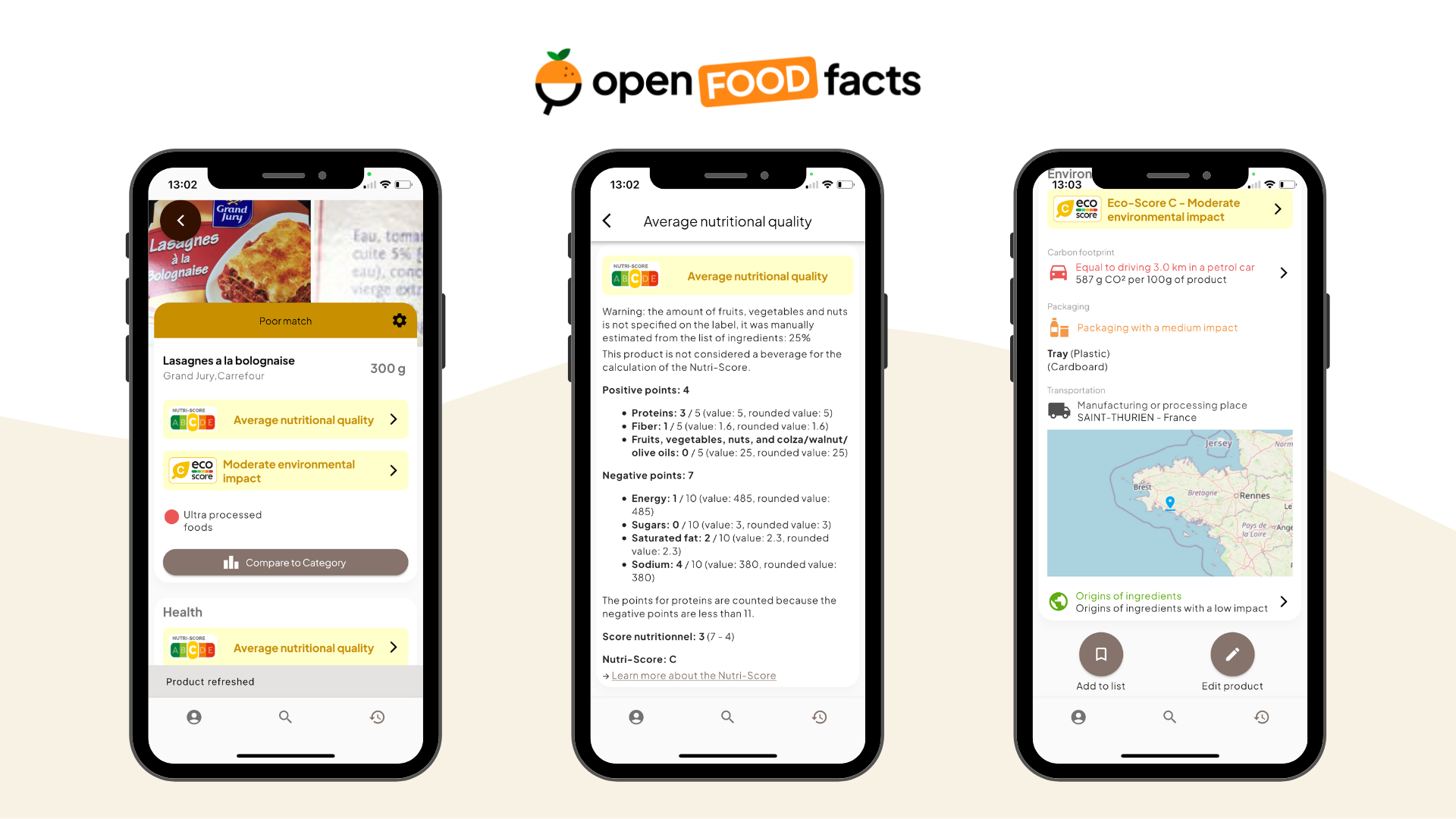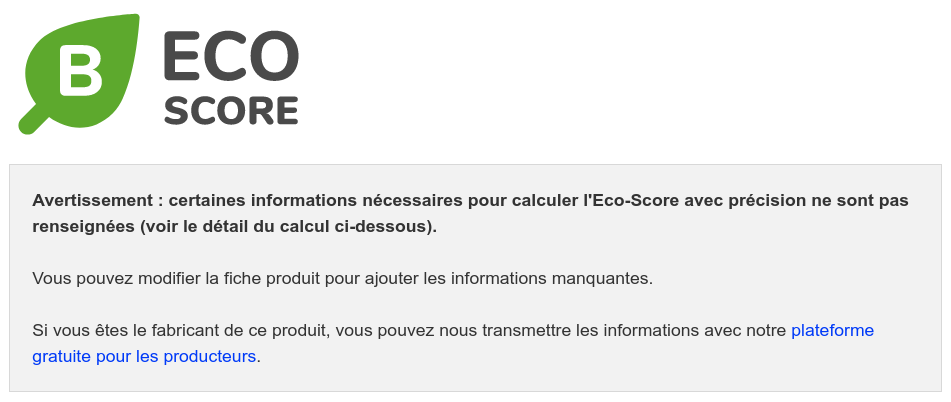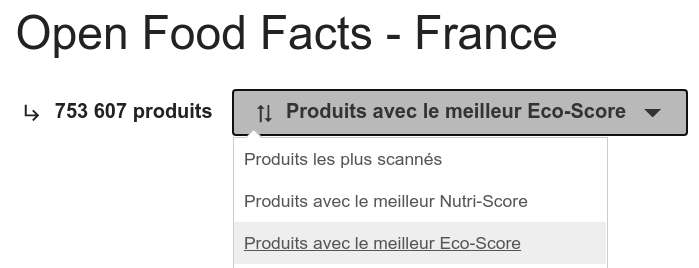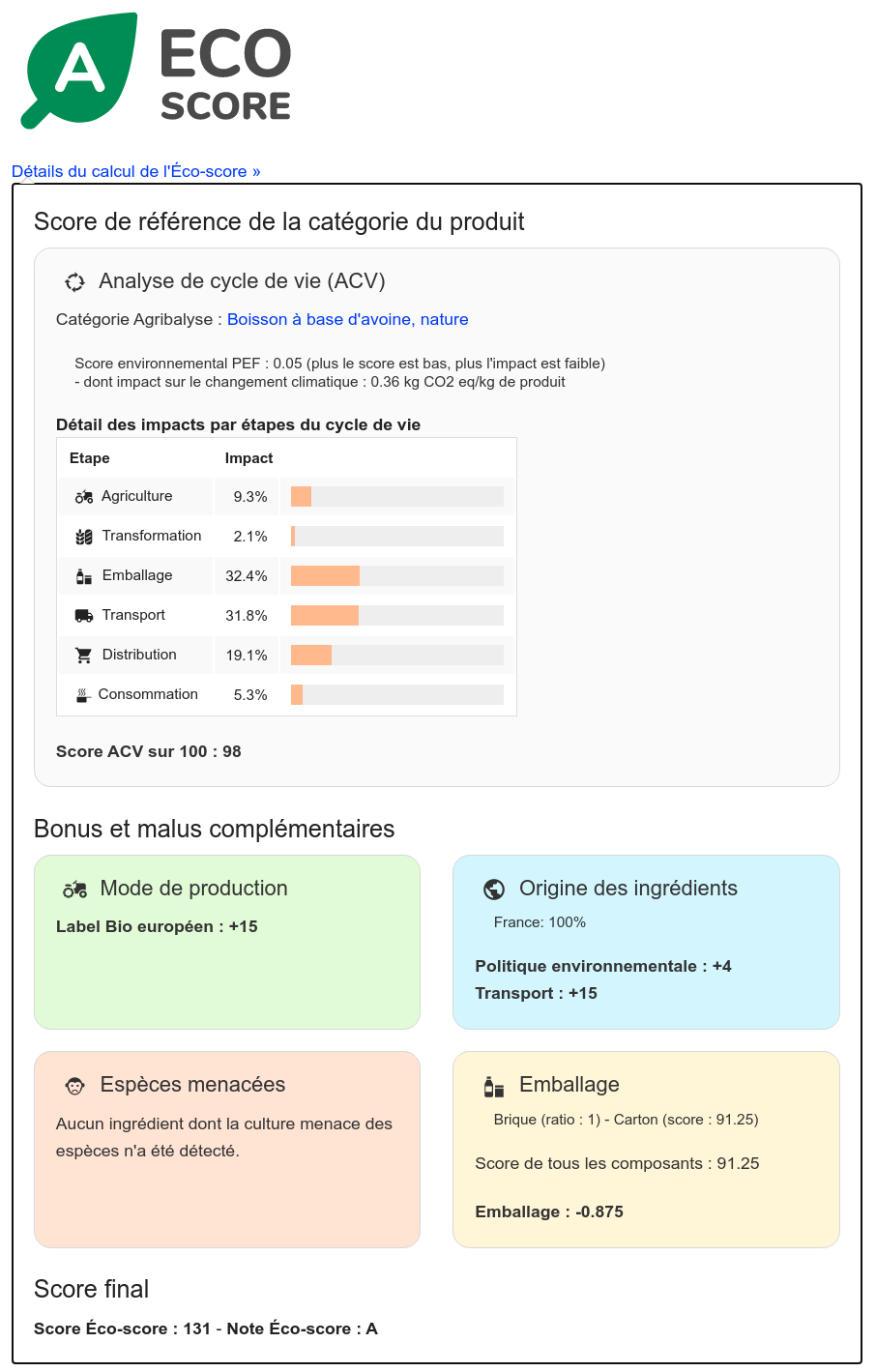Eco-Score: the environmental impact of food products

The Eco-Score is an environmental score (ecoscore) from A to E which makes it easy to compare the impact of food products on the environment.
- Why an environmental score?
- Vad är Eco-Score?
- Hur beräknas Eco-Score?
- The benchmark score: life cycle analysis (LCA) with data from the Agribalyse database
- Bonuses and penalties to refine the grading of each product
- An increased need for transparency to better measure and reduce environmental impacts
- How to see the Eco-Score for food products?
- Scan products with the Open Food Facts app
- Compare the Eco-Score of products on the Open Food Facts site
- How the Eco-Score can encourage the improvement of products and the reduction of their environmental impacts
- How can we find out more and how can we help us develop the Eco-Score?
- Acknowledgments
- Referenser
Why an environmental score?
More and more consumers are concerned about the impact of their food not only on their health, but also on the health of our planet. Thanks to the Nutri-Score, it is now very easy to take into account the nutritional quality of products when purchasing, but it is very difficult if not impossible to compare their environmental footprint.
It is urgent to provide consumers with clear information about this environmental footprint, so that they can easily and quickly compare it for several products. This is what the Eco-Score environmental grade allows.
The Eco-Score, a tool for more sustainable food
The Eco-Score helps consumers who wish to move towards a more sustainable diet, by encouraging them to:
- Ät mindre kött men av bättre kvalitet
- Consume more organic products and products with quality labels
- Favor local and seasonal products, with little packaging
- Limit products containing problematic ingredients (endangered fish, unsustainable palm oil)
Vad är Eco-Score?
The Eco-Score is designed on a model similar to the Nutri-Score: it is a grade from A to E which summarizes 15 environmental impacts. The Eco-Score score is materialized by a colored leaf-shaped logo with a letter from A (very low impact) to E (very high impact).

The Eco-Score is supported by a consortium of many actors committed to better nutrition.

Hur beräknas Eco-Score?
The benchmark score: life cycle analysis (LCA) with data from the Agribalyse database
For each product category, a benchmark score is established using data from the Agribalyse environmental database designed by ADEME and INRAE. These data correspond to the life cycle analysis (LCA) of the products.
Life cycle assessment (LCA)
Life cycle analysis is a standardized assessment method for carrying out a multi-stage environmental assessment and multi-criteria:
- 6 production steps: agriculture, processing, packaging, transportation, distribution and consumption
- 14 environmental impact indicators: climate change/carbon footprint, ozone layer depletion, ionizing radiation, land, water, and energy use; pollution of air and marine and fresh water (particles, acidification, eutrophication); and depletion of resources.
Bonuses and penalties to refine the grading of each product
In order to take into account certain impacts on the environment which are not covered well by the life cycle analysis (such as biodiversity) and the specificities of each product within the same category, the score of reference is modulated with bonuses and penalties:
Produktionssätt
A bonus is awarded to products that have an official label, a label or a certification that guarantees environmental benefits (organic, fair trade, HVE, Label Rouge, Bleu Blanc Cœur, MSC/ASC).
Ingredients ursprung
A bonus is awarded based on the origin of the ingredients. This bonus takes into account the impact on transportation and also the environmental policy of each producer's country.Utrotningshotade arter
A penalty is given to products that contain ingredients that have significant negative impacts on biodiversity and ecosystems, such as palm oil, the production of which is responsible for massive deforestation.
Förpackning
En straffavgift beräknas för att ta hänsyn till förpackningens cirkularitet (användning av återvunnen råvara och återvinningsbarhet) och överpackning.
An increased need for transparency to better measure and reduce environmental impacts
To accurately calculate the Eco-Score, it is necessary to have information which is not necessarily specified on the packaging (such as the origin and the exact percentage of each ingredient) or which is rarely available in usable form (such as a list of all the components of the packaging with the precise types of plastics used).
Average values are used when this information is not yet available, but we are now calling on everyone to help us collect this information which will be very useful for the Eco-Score but also for many other uses.
- Manufacturers can send us their information directly through our free platform for producers.
- All citizens can help us gather and structure the information that is present on products or that can be deduced from them, such as information on packaging: Mission Emballages: a large-scale collaborative inventory of packaging for all food products (in French)
How to see the Eco-Score for food products?
Scan products with the Open Food Facts app
The Open Food Facts app allows you to quickly get the Eco-Score of products: all you have to do is scan their barcode. If you have already installed the Open Food Facts app, please update it to get the new version!

Eco-Score är, eller kommer snart, att vara tillgängligt i lanseringspartnernas appar. And Open Food Facts is a Wikipedia of foods that anyone can reuse freely and for free. De mer än 100 applikationer som använder OFF-databasen kommer också att kunna visa det beräknade Eco-Score.
Compare the Eco-Score of products on the Open Food Facts site
Webbplatsen Open Food Facts gör det möjligt för alla att se och jämföra Eco-Score för mer än 750 000 livsmedelsprodukter som säljs i Frankrike. The results of each search show the nutritional quality with the Nutri-Score, ultra-processed foods with NOVA, and the environmental impact with the Eco-Score. Eco-Score kommer att rullas ut till andra länder så snart en tillämplig Eco-Score-beräkning är tillgänglig.

The Eco-Score of prepared meals on Open Food Facts
Classify and explore products by Eco-Score on Open Food Facts
And see at a glance the Eco-Score of the products of a category or a brand.

The Eco-Score of prepared meals. Click to see the products for each grade on Open Food Facts.
Få detaljerna om Eco-Score-beräkningen för alla produkter
För varje produkt kan du med en länk visa alla detaljer för beräkningen av Eco-Score-poängen.
And if information is missing, anyone can add it: the manufacturer of the product but also all citizens committed to the climate, environmental protection and transparency.

How the Eco-Score can encourage the improvement of products and the reduction of their environmental impacts
The Eco-Score has two levers of action:
- Med Eco-Score kan konsumenter göra ett mer informerat val genom att ta hänsyn till produkters miljöpåverkan som ett valkriterium.
- Eco-Score uppmuntrar också tillverkare att förbättra sina produkter så att de uppnår ett högre Eco-Score-betyg.
Tillverkare som förbättrar miljöpoängen för sina produkter är det ultimata målet, eftersom det kommer att gynna alla konsumenter.
Energiklassificeringen för hushållsapparater har alltså djupt förändrat marknaden (försök att hitta ett kylskåp klassificerat E, eller till och med D eller C!). And the democratization of Nutri-Score has also encouraged many manufacturers to improve the nutritional quality of their products to obtain a better rating (to the point that some French manufacturers even brag about it on bus stops, such as Brossard for its Savane cake).
To encourage product improvements, our platform for producers automatically analyzes data provided by manufacturers to identify avenues for improvement. The platform thus identifies all the products that would obtain a better Nutri-Score score with a slight change in composition (a reduction in salt of 5% for example).
Soon, the platform will make it possible to suggest ways to reduce the ecological impact and obtain a better Eco-Score (for example by using a more recyclable plastic for packaging, or by replacing palm oil with another oil).
How can we find out more and how can we help us develop the Eco-Score?
Everyone is welcome to help us create more transparency, educate consumers, and encourage product improvement through Eco-Score.
The Eco-Score is still young and can certainly be improved. Given the climate and environmental emergency, however, it seems important to us to make it available now.
Genom att arbeta tillsammans kommer vi att gradvis kunna förbättra Eco-score, förfina dess formel och samla in de data som behövs för beräkningen.
Your feedback, observations and suggestions will therefore be very valuable.
- If you are a journalist and want to know more, you can contact Pierre Slamich - pierre@openfoodfacts.org- +33 6 02 13 14 57
- Om du är en tillverkare, kan du skicka oss information om dina produkter med vår gratisplattform för producenter, och få den detaljerade Eco-Score-beräkningen för alla dina produkter. For any questions: producers@openfoodfacts.org
- If you are a citizen, you can install the Open Food Facts app, create an account on the Open Food Facts website, join our community of engaged citizens and our Slack discussion space. For any questions: contact@openfoodfacts.org
Open Food Facts is a collaborative project supported by tens of thousands of volunteers
and managed by a non-profit association with 3 employees.
You can help us at fund Open Food Facts 2023 budget
and continue to develop the Eco-Score and many other projects to improve everyone's diet. Tack! ❤️
Acknowledgments
Tack till teamen från ADEME, l'INRAE a> och alla Agribalyse-partners för upprättandet av denna unika miljödatabas och dess publicering i öppna data.
Thank you to all those involved in creating a common Eco-Score.
Thanks to the organizers and volunteers of Data For Good who greatly improved the artificial intelligence algorithms of Open Food Facts.
Tack till AFNIC Foundation för dess stöd för implementeringen av Eco-Score i Open Food Facts.
Thanks to Santé publique France (Public Health France) for its crucial support for the development of the platform for producers.
And thank you to all the participants in the Open Food Facts project who for more than 8 years have been promoting food transparency to improve everyone's diet!
Referenser
- Announcement of the launch of the Eco-Score on the Open Food Facts blog
- Open Food Facts App for iPhone on the App Store
- Open Food Facts App for Android on the Play Store
- The distribution of Eco-Score scores for products on the Open Food Facts site
- Detailed documentation of the methodology and formula for calculating the Eco-Score. (på franska)
- Agribalyse environmental base of ADEME and INRAE (in French)


